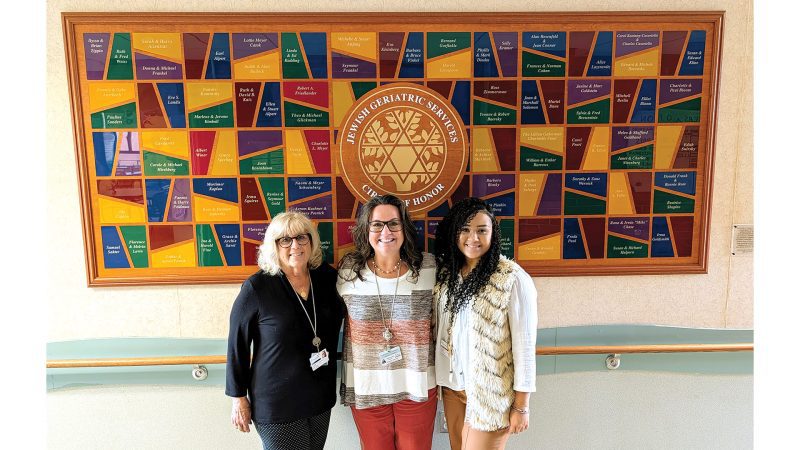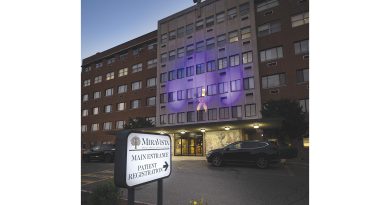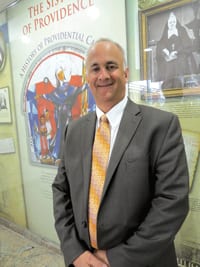JGS Lifecare Puts Focus on Effective Memory Care
Empathy and Engagement
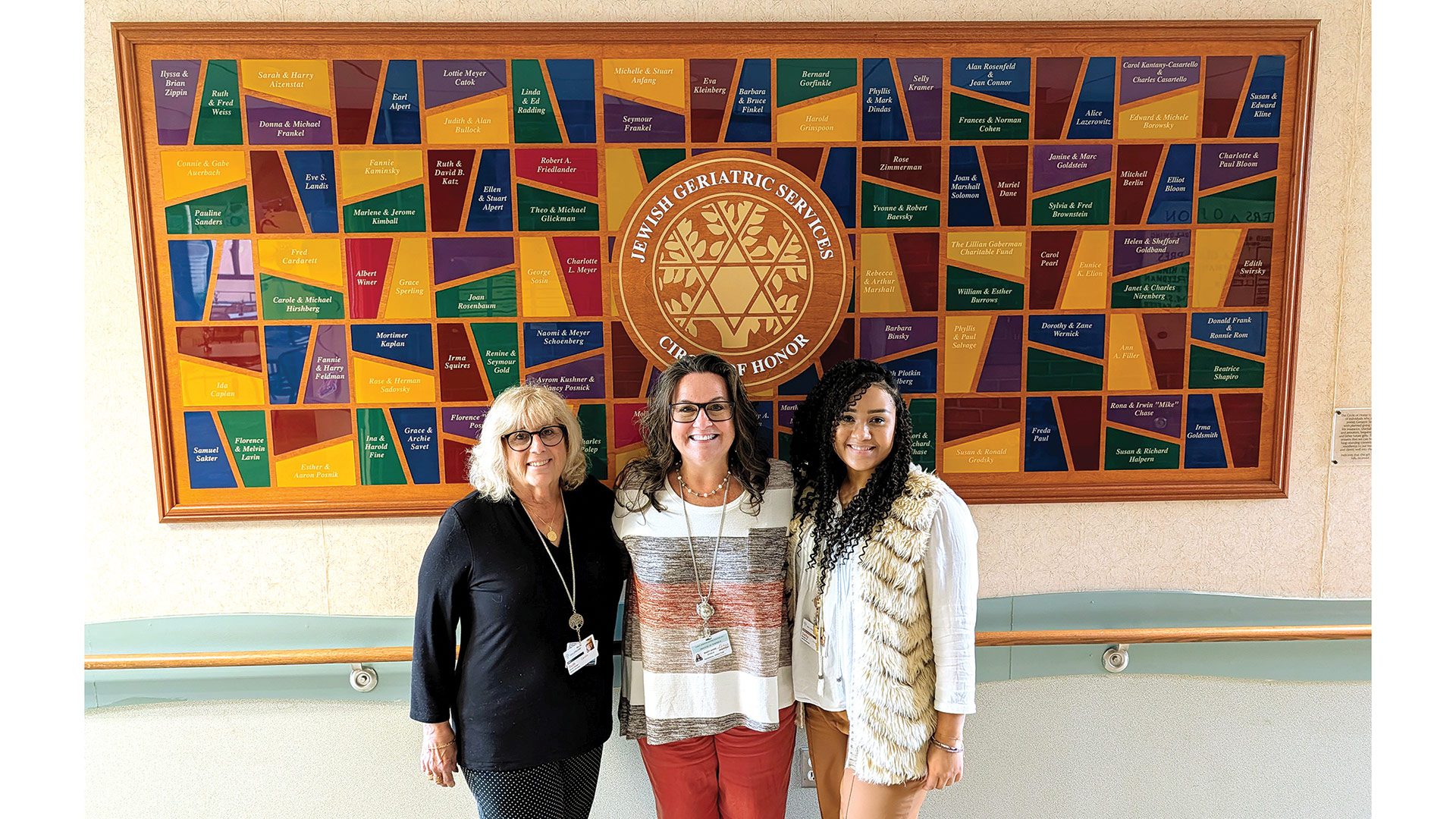
While explaining the many ways in which JGS Lifecare folds memory care into all its services, Delila Jones noted that she’s a certified trainer in the Virtual Dementia Tour, a process that every employee on the campus goes through, no later than day two.
“We put our staff in the shoes of someone who has dementia. That’s done by providing external stimuli and an environment to replicate what would be confusion, anxiety, neuropathy, lack of dexterity in your fingers, visual limitations,” said Jones, Life Enrichment director at JGS.
“We do all those things as kind of a crash course into what it would feel like to be in the shoes of someone with dementia for a total of eight minutes — and that’s really all it takes. Eight minutes, and staff members cry. They come out changed because they’re getting an understanding, on a personal level, of what it feels like to be out of control. It allows us to reach the heart of what it’s like and then give them the compassion and empathy they wouldn’t receive if they didn’t go through the experience.”
Beth Cardillo, a long-time regional leader in the memory care field who now works part-time at JGS as a geriatric social worker in the Leavitt Family Jewish Home, a skilled nursing facility, has plenty of experience with the Virtual Dementia Tour, which simulates the physical and sensory challenges of dementia using special goggles, headphones, and gloves that distort vision, hearing, and touch. And she understands its impact.
“This is a truly unique experience. One of the takeaways we hear from everybody when we ask, ‘what did you get from this eight-minute experience?’ is ‘slow down, slow down your life, slow down the way you talk to people.’ It takes 90 seconds for somebody with Alzheimer’s to process what you say to them. Normally, we talk so fast and we’re so busy and really haven’t learned to slow it down. And it just makes a huge difference.”
Jones agreed. “I kind of measure the success of our training with how many people cry because I feel like you’ve got to touch the heart. You have to reach the heart in order to really get that point driven through — because, unfortunately, dementia breaks hearts. So in order for us to care properly, we have to kind of have a broken heart for them.
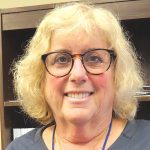
“It takes 90 seconds for somebody with Alzheimer’s to process what you say to them. Normally, we talk so fast and we’re so busy and really haven’t learned to slow it down. And it just makes a huge difference.”
“And it’s truly effective,” she went on. “Just this week, we did our dementia training, and I had two or three CNA staff say, ‘we were CNAs for years, we know that we’re good staff, but I need to up my game. I didn’t realize that I can improve.’ And to have someone reach a point where they’re evaluating themselves and looking to improve because of this training, because they’re learning something new about what it’s like to have dementia, I think that’s a success.”
The Garden, a separate, secure neighborhood in the Ruth’s House assisted living facility on the Longmeadow campus, specifically caters to individuals with increased cognitive and physical limitations, including Alzheimer’s and other forms of dementia. But JGS has, over the years, incorporated specific memory-care training across its continuum of services, from Legacy Lifecare VNA & Hospice to Wernick Adult Day Health Care; from the Leavitt Family Jewish Home (where 80 of 200 beds are secure) to the Sosin Center for Rehabilitation.
That’s because the memory-care population is on the rise as Americans live longer than ever — and early-onset dementia in younger people is ticking up as well. So the model JGS has adopted, making sure all the points along its continuum of services can handle different levels of dementia, has become dominant in the world of senior living and care.
“I really work hard with families to help them understand that their loved one is in the right place, and that we are going to do everything for that experience to be as purposeful as possible,” Cardillo said.
“People just feel an incredible amount of guilt: ‘my mother took care of me, but I can’t take care of my mother at home anymore.’ But at some point, things change. ‘I promised my mother she would never go into a nursing home.’ Well, at some point those negotiations are off the table. You just can’t do it,” she added, explaining the transition so many families experience when choosing a residential memory care situation, whether assisted living or skilled nursing.
“The nursing home is more of a medical model. We’re more equipped to deal with medication changes and things like that more quickly,” she said. “And the training with the staff is called a habilitation model, where, unless it’s a safety issue, the resident is always right. We want to avoid conflict. We want to make it as engaging as possible.
“I really work hard with families to help them understand that their loved one is in the right place, and that we are going to do everything for that experience to be as purposeful as possible.”
“Do I care if someone thinks it’s Friday, and it’s Tuesday? No. Whatever he thinks, unless it’s safety, I don’t care. Make it Friday, make it Christmas, make it whatever. All good,” she went on. “And I think we work hard at promoting that. It’s all about relationships that we develop with our residents in the nursing home. They can read your mind. They know if you’re on your game that day or not. And it’s up to us to provide the best relationship we can with each person.”
Home and Garden
Then there’s Ruth’s House, the assisted living facility with its own dedicated memory neighborhood, the Garden, where employees are specifically trained to care for this population.
“When it comes to caring for those who have memory issues, we adapt to them, as opposed to someone who may not have those issues, and are able to communicate their needs properly and efficiently,” Jones said.
“When it comes to someone who’s living with dementia, we are the ones that have to adapt. We are the ones that have to become the detectives and be purposeful in everything that we do for them. We are more sensitive and gear everything toward how they may respond. We are more fluid. It’s more organic,” she went on.
“When we are facilitating programs, we’re also seeing how this person feels today. It’s very important that all of the staff are trained and educated to work with those living with various forms of dementia because it’s a whole different world. It’s a whole different way of communicating.”
In that setting, Jones said, the staff makes sure to provide a daily schedule of activities that engage the whole person — physically, emotionally, socially, and spiritually — while also communicating with families who may be anxious about their loved one’s experience.
“We take the same approach we’d have toward all the seniors [at JGS Lifecare], which is compassionate care, understanding, empathy, making sure that their feelings are validated, and then working together as a team to accomplish a goal together collectively,” she explained. “That’s really important when it comes to families as well — because we are that bridge to connect the families to these seniors living with various forms of dementia. The families are pivotal in the care of the seniors. So, we must maintain a very healthy relationship with the families.”
“The families are pivotal in the care of the seniors. So, we must maintain a very healthy relationship with the families.”
Families — often with the help of the resident — also fill out what’s called a resident profile, a kind of life story including a social history, background, education, interests, hobbies, and more. “It allows us to have the information and the tools to have a personalized approach to care as they join us in living here,” Jones said. “With that information, if I know Mary was a teacher, then I can definitely tap into that, no matter what stage of dementia she’s in.”
Tapping into personal history is important across the campus, even outside the dementia neighborhood. One five-year resident of Ruth’s House, Johnny Scalia, affectionately known as “Johnny Rocket,” is a DJ with infectious energy who has shared his musical mixing skills with residents and families over at the Leavitt home. “I’m living my best life here,” he said. “The music keeps me going — and I love making people happy.”
Mary-Anne Schelb, regional director of Business Development at JGS, told BusinessWest that care at any of the JGS facilities is “really a matter of meeting people where they are.”
The Garden at Ruth’s House also features a sensory room, highlighted by a high-definition projector that shows soothing scenes on a wall — think ocean, nature, and the like.
“It’s so soothing and calming and inviting,” Jones said. “Just recently, for a resident who is on hospice and who has a hard time connecting in certain programs, we played a classical symphony through this projection. It was like you were there. And his caretaker was in tears, seeing how he was able to enjoy that moment with something that he passionately loved.”
Schelb added that the room is also used to de-escalate if somebody gets a little bit agitated or is sundowning. “It’s a very calm space that is utilized to decompress or kind of level them out. And it’s been very, very successful.”
Growing Need
About 7 million Americans live with Alzheimer’s disease, a number projected to rise to nearly 13 million by 2050, according to the Alzheimer’s Assoc., mainly due to the aging of America and the soaring over-65 population. That makes it critical for senior living communities to offer specific care to people with memory issues.
“However, I would like to point out the advent of new medications and infusions that are happening now,” said Cardillo, who serves on the executive leadership committee of the regional Alzheimer’s Assoc. chapter. “In the last five years, we have some medications that are actually looking at getting rid of the amyloid plaque in the brain, not just treating the symptoms. We have some new medications for people that are in the beginning stages, and it’s promising — I think it’s a springboard for better medications to come.”
What that means, she believes, is that “we are going to see the first survivor of Alzheimer’s in our lifetime.”
In the meantime, JGS Lifecare will continue to take care of those living with dementia locally.
“We genuinely want to take care of the person as a whole, and we’re providing various forms of engagement and opportunities to provide quality of life to our seniors,” Jones said, noting, as one example, a staff member who helps residents use an Oculus Quest headset to allow residents to access virtual reality experiences, “to walk through an ocean or get an experience on a different side of the world. And this is all thanks to the technology that we have today.
“So we’re growing; we’re expanding. We’re providing quality of life with just crayons and paper, if that’s something that they enjoy, or paint. But we’re also transforming for the current age, moving forward with technology, and I’m pretty proud of where we’re going.”
“And,” Cardillo was quick to add, “we’re not just treating our residents — we’re treating our families.”

